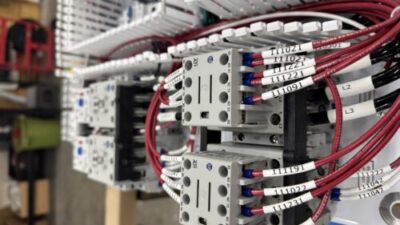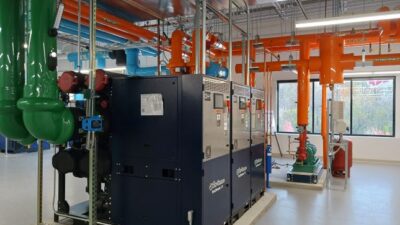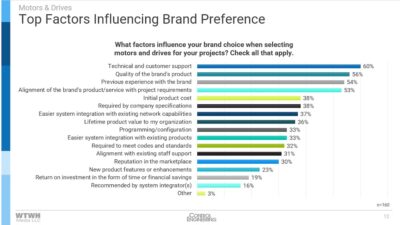Of all resources on which modern manufacturing is dependent, energy is arguably the most fundamental. It is also a resource that has long been taken for granted. However, rising energy prices and compliance concerns related to greenhouse gas emissions in some industries are increasingly leading operators to critically assess their energy usage.
|
| Energy accounts for the largest part of the total cost of operating a pump or fan motor. |
Of all resources on which modern manufacturing is dependent, energy is arguably the most fundamental. It is also a resource that has long been taken for granted. However, rising energy prices and compliance concerns related to greenhouse gas emissions in some industries are increasingly leading operators to critically assess their energy usage.
Lack of standards = inefficiencies
A recent presentation to the American Council for an Energy Efficient Economy referenced a study that looked into the internal practices of a leading chemical company and of two major engineering contractors that company used on recent projects. The focus of the study, “Energy Efficiency for Industry,” was to identify whether the size of the installed pumps matched the real need. The results showed that 90% of the pumps were not correctly sized. If such a high percentage of installations are incorrectly matched in this company, how many are equally mismatched in other companies around the world?
| The “true” condition of this sample application, 100 units of flow, requires 4,000 units of pressure (point “a”) |
| Ten percent reserve “b” is added to the fan specification “a”, to be on the safe side concerning maximum flow. |
rs add to the risk that the expected operating conditions will not be met. As a result, there are three basic ways to address the changed operating conditions with the right devices for the system:
-
If the changed condition is permanent, then the pump or fan size should be changed to match the load;
-
The pump or the fan speed can be changed; and/or
-
A throttling device (such as a valve, damper or guide vane) can be added, although this is wasteful of energy.
The cost of energy is the all-dominating part of the lifecycle cost of a pump or a fan motor (see “Energy cost of pump/motor” graphic). Therefore, energy consumption is the best place for optimization to start.
Why systems get supersized
To compensate for all the potential factors that could adversely affect a system’s function, industrial system designers will often overcompensate for the needs of the system. This results in many systems simply being sized too large to start with, resulting in higher operating and investment cost. To illustrate this, consider the following case example of a system with a fan in a process industry application.
In this example, it is assumed that the “true” condition of the application, 100 units flow, requires 4,000 units of pressure (point “a” in the “Fan motor application #1” graphic).
In order to be on the safe side concerning the maximum flow, the figure for the fan that is communicated to the engineer is 110 units of flow (point “b” in “Fan motor application #2” graphic). Based on the assumed system, this would require a fan with a higher capacity (dashed green line in #2 graphic) that can deliver 110 flow units and 5,000 pressure units.
When establishing the fan capacity, the fan system engineer estimates the overall pressure drop that these 110 flow units will cause (point “c” in “Fan motor application #3” graphic). The pressure drop value that is calculated is increased by a 10% margin (point “d” in graphic #3) because it is difficult to foresee whether the assumed number of 90-degree turns in the duct will conform to the amount estimated (the contractor installing the fan may have to add turns to bypass other equipment). A smaller cross section would lead to a higher pressure drop. Such a 10% margin is therefore not unreasonable.
So what data are finally sent out in the requests for quote? Flow: 110 units at a pressure of 5,500 units (point “e” in “Fan motor application #4” graphic). If the original assumptions were correct, the fan is now grossly oversized. At 100 units flow, the necessary additional pressure drop over the damper must be about 2,800 units (point “f” minus point “g” in graphic #4). This corresponds to 70% of the assumed correct total pressure. However, it is rare that 100% of the design flow will be needed other than for very short bursts. Assuming that most of the time, 80% of the flow rate will be required, the additional throttling needed in the damper will be about 6,000 units (point “h” minus point “i” in graphic #4). This corresponds to 150% of the assumed correct total pressure.
The steps illustrated in this example are more common than they may seem. Furthermore, when it comes to the selection of a fan, this choice must be made from a standard range of fixed sizes. Therefore, the next larger one will usually be chosen.
The correctly sized fan for this example should be 100×4000 = 400,000 power units. The case above produces a requirement for a fan of at least 605,000 power units (150% of the optimum). Correcting this with damper control leads to high levels of wasted energy. The additional losses at the 80% flow point amount to 480,000 power units (120% of the full power of a correctly sized fan). With a speed controlled fan instead of damper control, most of this energy can be saved.
| Author Information |
| Article authors: Per Wikstroem, ABB Switzerland; Jukka Tolvananen and Akseli Savolainen, ABB Oy Drives, Finland; Peter Barbosa, ABB Corporate Research, Switzerland. More info: |
Energy benefits of drives
Chapter two of The World Energy Outlook 2006 (published by the International Energy Agency) states: “Global primary energy is projected to increase by 53% between 2004 and 2030—an average annual increase of 1.6%. More than 70% of this increase comes from developing countries.”
Given such a trend toward global increases, how are reduction targets, regardless of the source, to be reached?
In several installations worldwide, ABB has used the application of drives to save significant energy costs. For example, the use of a drive with a fan in a palletizing plant in Colorado saved 35%, or 2,423,750 kWh. Similarly, the use of drives with booster pumps in a metals plant in Taiwan saved 61% in annual energy costs by reducing usage by 3,030,720 kWh (see table below). By weighted average, these installations have slashed energy consumption by 42%, according to ABB.
| Company | Industry | Application | No. of drives installed | Confirmed power [kW] | % saved [kWh] |
| Source : Control Engineering with data from ABB | |||||
| Peña Colorada | Mining | Fan in palletizing plant | 1,250 | 2,423,750 | 35% |
| China Steel Taiwan | Metals | Booster pumps | 672 | 3,030,720 | 61% |
| Cruz Azul, Mexico | Cement | Kiln ID fan 1+2 | 1,470 | 5,309,640 | 54% |
| Repsol YPF, Argentina | Petro-chemical | Blower (steam turbine replacement) | 3,000 | 7,560,000 | 43% |
| Daqing Plastic Factory, China | Petro-chemical | Mixer | 1,300 | 2,600,000 | 31% |
The drive to save energy
According to a study by Lappeenranta University of Technology (LUT) in Finland, pump control based on variable speed drives can deliver energy savings of up to approximately 70% in parallel pumping installations. The biggest savings can be achieved in situations where there are significant fluctuations in the flow.
The project was undertaken at the LUT’s Department of Energy and Environmental Technology. It set out to quantify the differences in energy consumption in four applications with three different flow control methods. The simulations were performed with Matlab v 6.1 and Simulink software, and the results were verified with actual measurements. The control methods compared were throttle control, standard pump control, and optimized pump control:
Throttle control: one pump is throttled and the others are on/off controlled.
Standard pump control: one pump is controlled by a variable speed drive (VSD) and the others are on/off controlled.
In optimized pump control, each pump has its own VSD and the required flow is divided evenly between all the pumps. As a result, their rotational speed is the same. (This case differs from the standard model in that the pumps are switched on and off in an optimized way. Optimized pump control technology is subject to a patent application by ABB.)
The first simulated industrial example used in the study is typical of real-life industrial pumping situations where new control technology can be applied. The example was taken from a Finnish paper mill, where Ahlstrom APP22-65 centrifugal pumps are used to pump chemically treated water to a desalination unit. An energy analysis of the pumping facility was used as the basis for the simulations.
The simulations, which relied on simplified system and duration curves, showed that, in this case, throttle control uses considerably more energy than the other control methods (see “Paper mill energy consumption” graphic). Optimized pump control is by far the most energy efficient method. The difference between standard and optimized pump control is more than 45%. The consumption of specific energy with throttling is nearly three times that of optimized pump control.
| Control methods | Energy consumption | Flow | E s | |
| (J/24 h) | (%) | (m | (J/m | |
| Source : Control Engineering with data from ABB | ||||
| Throttle control | 177,114 | 0.0 | 2254 | 78.58 |
| Standard pump control | 102,786 | -42 | 2257 | 45.54 |
| Optimized pump control | 57,050 | -68 | 2256 | 25.29 |
Bosch Rexroth launches sustainable technology Website
Bosch Rexroth has launched a new Website to provide information on its sustainable manufacturing technology resources and to help encourage innovation among manufacturers, OEMs, machine builders, system integrators and engineers. Visitors can access the new Website at
The site features descriptions of key products and systems Bosch Rexroth has developed to encourage use of alternative energy sources, such as its hydrostatic regenerative braking (HRB) systems. HRB systems, designed for commercial vehicles, store brake energy in a hydraulic pressure reservoir to relieve the load on the main drive when the vehicle is accelerating, potentially reducing fuel consumption by up to 25%.
Here’s how the HRB system works: When the driver presses the brake pedal, a hydraulic unit integrated in the drivetrain presses the hydraulic fluid into a high-pressure reservoir. The resulting resistance makes the vehicle decelerate. When accelerating, the hydraulic pressure reservoir is controlled electronically to release the pressure, and it relieves the load on the diesel engine. As a result, the engine consumes less fuel, generates fewer exhaust gases, and functions more quietly.
The new site also provides links to case histories describing how Rexroth technology helps machine builders and manufacturers reduce waste, improve sustainability, use renewable resources, and conserve energy.



